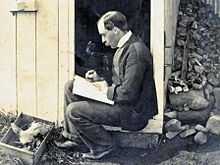Arthur Bulleid
| Arthur Bullied | |
|---|---|
 | |
| Born |
24 June 1862 Glastonbury |
| Died | 27 December 1951[1] |
| Nationality | British |
| Fields | Archaeology |
| Known for | Excavation of Glastonbury Lake Village and Meare Lake Village |
Arthur Bulleid (1862-1951) was a British antiquarian, known for the excavation of Glastonbury Lake Village and Meare Lake Village.
He was born in Glastonbury, the sixth son of John Bulleid, the mayor and founder of the Glastonbury Antiquarian Society,[2] and his wife Christina.[3] He became a medical student but was interested in local history and archaeology. In 1900 he was married to Anna Elanor Austin. They lived at Dymboro, Midsomer Norton and had six children.[4]
In his twenties he heard about the discovery of lake villages in Switzerland and suspected that similar Iron or Bronze Age settlements may exist on the Somerset Levels. He spent his summers searching for them and in 1892 identified a promising field at Godney and began to excavate it.[5] He gave up his medical studies to concentrate on the site which became known as Glastonbury Lake Village, digging during the summer and describing and cataloging his finds during the winter. In 1898 he stopped the excavation and completed his medical studies before restarting the dig in 1904 with Harold St George Gray.[6][7]
He later went on to excavate, with Gray, another similar site the Meare Lake Village. His work is commemorated in the Glastonbury Lake Village Museum at The Tribunal, Glastonbury.[8]
Bulleid died in 1951 and is buried in the cemetery, Wells Road, Glastonbury.
References
- ↑ "Obituaries". Isis 43 (2): 117–119. doi:10.1086/349406.
- ↑ "The Society". Glastonbury Antiquarians. Retrieved 1 February 2015.
- ↑ "Glastonbury Lake Village". Glastonbury Antiquarian Society. Retrieved 1 February 2015.
- ↑ "Bulleid and Gleeson 1849-1987" (PDF). Bulleid Family. Retrieved 1 February 2015.
- ↑ "Papers of Dr. Arthur Bulleid (1862-1951) of Glastonbury". National Archives. Retrieved 1 February 2015.
- ↑ "Papers of Dr. Arthur Bulleid (1862-1951) of Glastonbury". National Archives. Retrieved 1 February 2015.
- ↑ Minnitt, Stephen (2000). "12. The iron-age wetlands of central Somerset" (PDF). In Webster, C. J. Somerset Archaeology. Somerset County Council.
- ↑ Adkins, Lesley; Adkins, Roy (1992). A Field Guide to Somerset Archaeology. Dovecote Press. pp. 69–70. ISBN 978-0-946159-94-9.